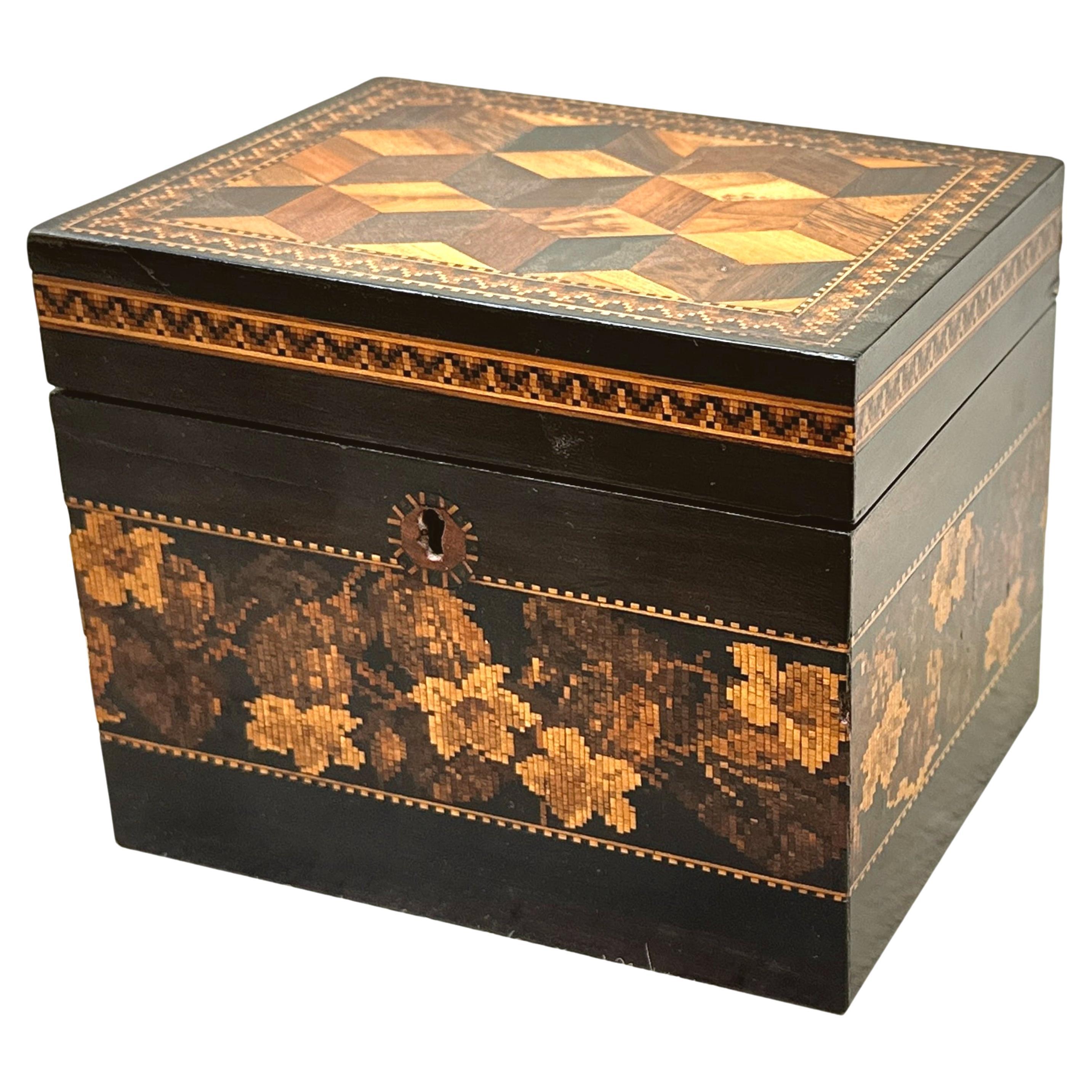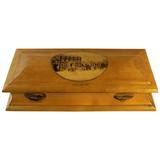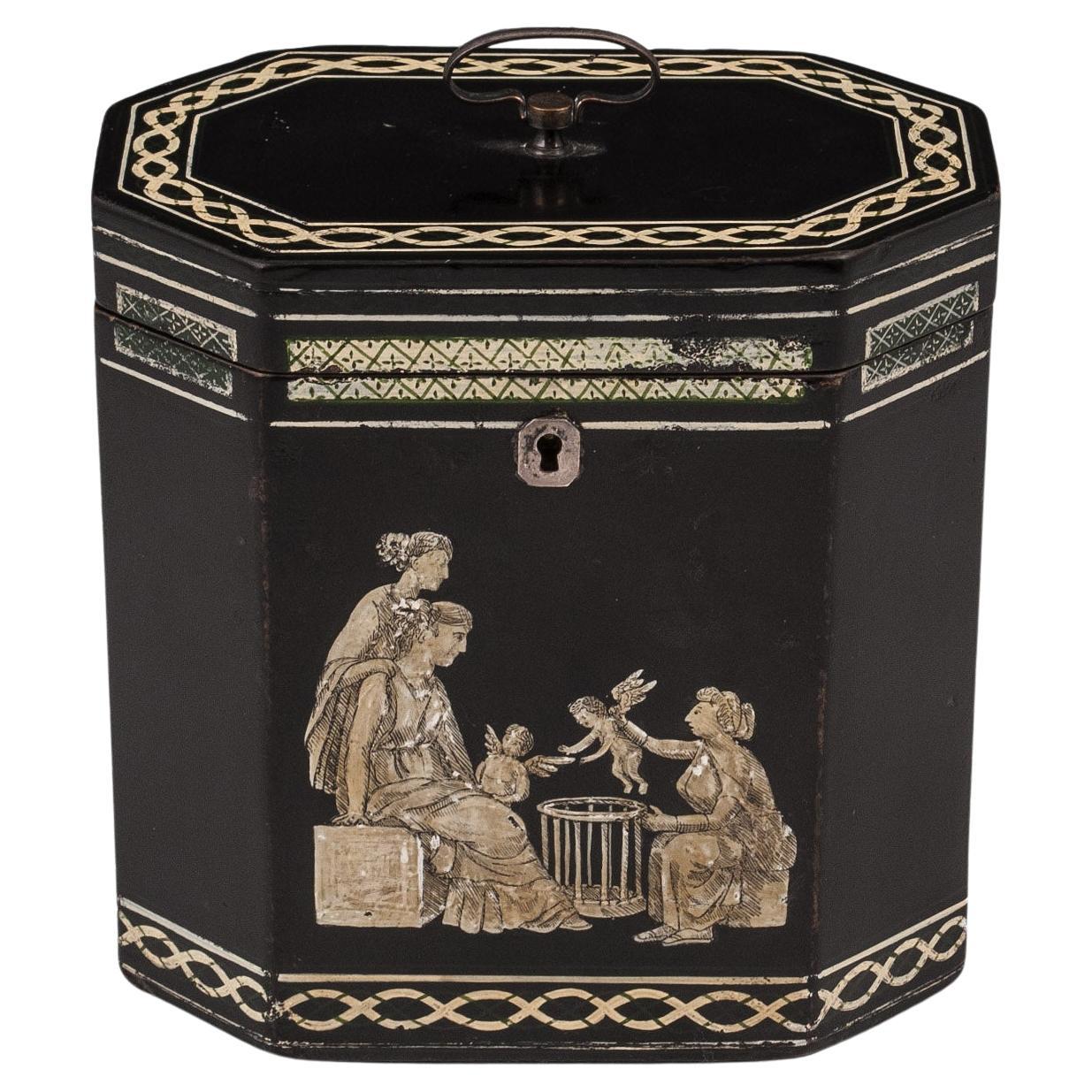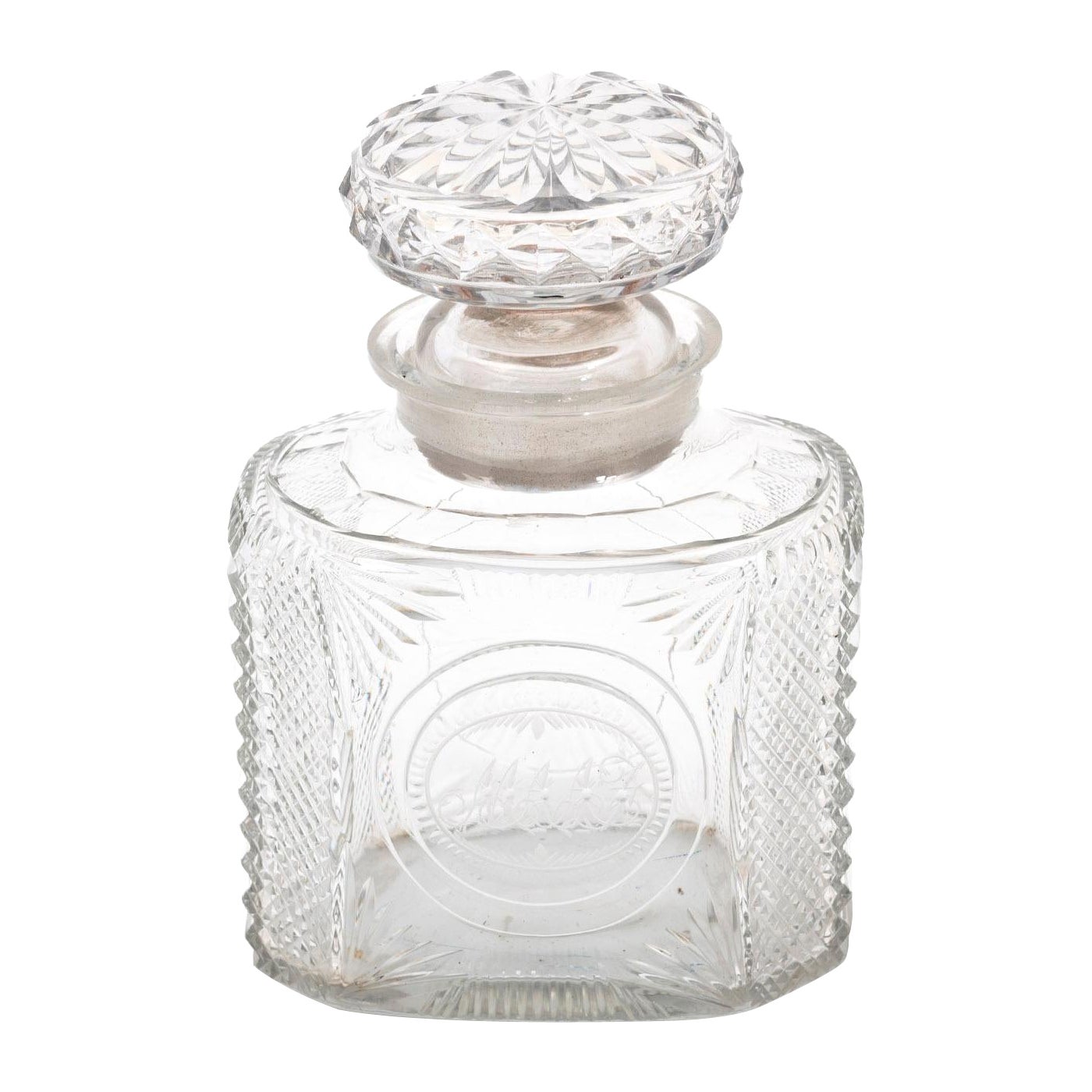Items Similar to Scottish Mauchline Ware Tea Caddy attributed to Smiths
Want more images or videos?
Request additional images or videos from the seller
Scottish Mauchline Ware Tea Caddy attributed to Smiths
About the Item
Scottish Mauchline Ware
From our Tea Caddy collection, we are delighted to offer this rare Mauchline Ware Tea Caddy. The Tea Caddy of rectangular form extensively decorated with a repeating pinstripe pattern throughout the entire exterior of the Tea Caddy upon a Sycamore carcass. The decoration features a striped effect with alternating classical scrollwork, linked chain and pin striped vertical line transfers in shades of gold, green and red. A shield-shaped escutcheon finishes the exterior of the Caddy. When opened the Tea Caddy reveals a single Caddy compartment with traces of the original foil lining and the Caddy the original full length wooden Cumnock Hinge. The Tea Caddy dates to the late Georgian Period during the reign of George IV Circa 1830. The Tea Caddy is a rare example of early Mauchline Ware especially because of the Type of decoration used and extremely good condition, a superb addition to any collection. We firmly attribute the Tea Caddy to renowned Scottish Mauchline Ware makers Smiths from the extremely close similarities between this Caddy and a previous one in our archives signed by Smiths.
The Tea Caddy comes complete with working lock and tasselled key.
Mauchline Ware was the production of Scottish white-wood products, it was mainly manufactured from the 1820s until 1939. The production of souvenir woodware for the tourist market began in the 1790s with the snuff box industry in Ayrshire. By 1820, Mauchline ware was well established, supplying souvenirs from wood grown ‘on the Field of Bannockburn’, ‘on the Abbey Craig’, ‘on the slopes of Stirling Castle’ and made into sewing requisites, egg cups, trinket boxes and many other kinds of souvenirs, transfer printed with a line drawing of the place. The firm Smith’s who regarded as the the leading and most renowned manufacturer of Mauchline War among a few lesser known and shorter lived companies. They ranged from the basic transfer as on small vases to boxes and smaller household accessories / useable objects each piece having the view of the place of purchase. The transfer subjects ranged across Scotland and more of the British Isles to the rest of the world. As a result of the early Mauchline Ware, Tartan ware became extremely popular after W & A Smiths invented a machine for “weaving” tartan designs on paper. Fernware was then introduced in the 1870s which involved applying actual ferns to the wood which was then stippled in dark brown. The ferns were then removed and the wood varnished. Sycamore was mainly the wood of choice across the whole product range. These products were sent all over the world and today there is a fierce collectors market, especially for the rarer pieces. Sadly a fire in 1933 stopped the entire production which was never restarted and Smith’s finally closed down in 1939. Smiths held a Royal Warrant and were makers to his majesty during the 19th century.
Smiths (later W & A Smiths) were the leading manufacturer of Mauchline Ware. Their Boxware Factory was located in Mauchline Ayrshire, West Scotland. Founded by Andrew Smith circa on 1831 who began by making snuff boxes. These boxes had a secret hinge called ‘The Cumnock Hinge’, and this type of box work had ‘Migrated’ to Mauchline from Cumnock where over one hundred and ten men and women were employed. The company suffered from two internal fires one in 1869 and a second in the late 1880s both times the firm rebuilt and introduced new machinery. This type of factory was prone to fires due to the inflammable nature of materials and the constant heat in the drying sections of the factory.
Sycamore also known as Harewood is a member of the Maple family, found in Europe. It is light yellow in colour and is often a very clean wood, with a straight, fine grain. The wood is often pippy. However, these pips are usually a very similar colour to the rest of the wood making them hardly visible.
- Dimensions:Height: 5.52 in (14 cm)Width: 5.32 in (13.5 cm)Depth: 4.53 in (11.5 cm)
- Style:William IV (Of the Period)
- Materials and Techniques:
- Place of Origin:
- Period:
- Date of Manufacture:Circa 1830
- Condition:Wear consistent with age and use.
- Seller Location:Northampton, GB
- Reference Number:
About the Seller
No Reviews Yet
Vetted Seller
These experienced sellers undergo a comprehensive evaluation by our team of in-house experts.
Established in 1998
1stDibs seller since 2023
13 sales on 1stDibs
Typical response time: <1 hour
- ShippingRetrieving quote...Ships From: Northampton, United Kingdom
- Return PolicyA return for this item may be initiated within 14 days of delivery.
More From This SellerView All
- Georgian Tea Caddy Henry Clay 'Attributed'By Henry ClayLocated in Northampton, GBOctagonal Papier-Mache Tea Caddy with Classical Figures Circa 1800 From our Tea Caddy collection, we are thrilled to offer this Henry Clay Octagonal papier-mache Tea Caddy. The Tea caddy decorated to the exterior with a central scene showing seated classical figures and cherubs. The top and bottom with Entwined diaper borders that are repeated on the hinged, silvered-handle top. The intior features a floating lid with a mounted silvered handle. Although unsigned we firmly attribute the Tea Caddy to renowned London maker Henry Clay. The Tea Caddy comes complete with working lock and key Henry Clay was an assistant to one of the pioneers in papier-mache by the name of John Baskerville who started to imitate the highly polished items, that were being imported from Japan, using lacquered...Category
Antique Early 1800s English Georgian Tea Caddies
MaterialsPaper
- Georgian Glass Tea CaddyLocated in Northampton, GBThe Tea Caddy of slight oval shape with diamond quit cut canted corners, an engraved monogram to the body reading MAAF and a radial cut stopper. The Tea Caddy dates to the late Georg...Category
Antique Early 19th Century English William IV Tea Caddies
MaterialsGlass, Cut Glass
- Georgian Inlaid Tea CaddyLocated in Northampton, GBFrom our Tea Caddy collection, we are pleased to offer this Georgian octagonal Inlaid Tea Caddy. The Tea Caddy of octagonal form veneered in Harewood with inlaid twin Tuscan Columns ...Category
Antique Late 18th Century English Georgian Tea Caddies
MaterialsBoxwood, Tulipwood, Harewood
- Georgian Satinwood Tea CaddyLocated in Northampton, GBWith Conch Shell Inlay From our Tea Caddy Collection, we are pleased to offer this superb Georgian Satinwood Tea Caddy. The Tea Caddy of rectangula...Category
Antique 18th Century English Georgian Tea Caddies
MaterialsBoxwood, Satinwood, Tulipwood
- Victorian Marquetry Tea CaddyLocated in Northampton, GBFeaturing Inlaid Hearts and Diamonds From our Tea Caddy collection we a pleased to offer this unusual Victorian Marquetry Tea Caddy. The Tea Caddy of unusual form with two outer Tea...Category
Antique Mid-19th Century English Early Victorian Tea Caddies
MaterialsBrass
- Georgian Tortoiseshell Tea CaddyLocated in Northampton, GBOval Tea Caddy with Silver Mounts From our Tea Caddy collection, we are delighted to offer this Georgian Silver and Tortoiseshell Tea Caddy. The Tea Caddy is of oval shape with a Tortoiseshell exterior mounted with engraved silver stringing, a silver shield plaque below the silver escutcheon and a silver looped handle. The interior features a floating tea shelf...Category
Antique Early 1800s English George III Tea Caddies
MaterialsSilver
You May Also Like
- Victorian Tunbridge Ware Tea CaddyLocated in Bedfordshire, GBA Charming 19th Century Tunbridge Ware Tea Caddy With Attractive Floral Band To Main Body And Parquetry Perspective Cubes To Hinged Lid Enclosing Lidded Interior. Tea was an extrem...Category
Antique Mid-19th Century English Victorian Tea Caddies
MaterialsOther
- 19th Century Scottish Mauchline Ware Jewelry or Trinket BoxLocated in Hamilton, Ontario19th century Mauchline Ware trinket or jewelry box. It has applied and printed monochrome decoration entitled “Mineral Wells Moffat”, “Moffat” and “Crai...Category
Antique 19th Century Scottish Jewelry Boxes
- Quality antique Victorian tunbridge ware inlaid tea caddyLocated in Ipswich, GBQuality antique Victorian tunbridge ware inlaid tea caddy having a lovely antique Victorian tunbridge ware inlaid tea caddy with beautiful detail to the box opening to reveal two rec...Category
Antique Early 19th Century Victorian Tea Caddies
MaterialsWood
- Eridge Castle Tunbridge Ware Tea Caddy c1860By Henry HollambyLocated in Tunbridge Wells, GBHeading : Two compartment Tunbridge ware tea caddy Date : c1860 Period : Victoria Origin : Tunbridge Wells, Kent Decoration : The cover decorated with Hollamby's version of Eridge Ca...Category
Antique 1860s British Victorian Tea Caddies
MaterialsWood
- Tunbridge Ware Tea Caddy with Herstmonceux Castle c1865By Henry HollambyLocated in Tunbridge Wells, GBHeading : Tunbridge ware tea caddy featuring image of Herstmonceux Castle Date : c1865 Period : Victorian Origin : Tunbridge Wells, Kent Decoration : Central mosaic depicting Herstm...Category
Antique Mid-19th Century English Victorian Tea Caddies
MaterialsWood
- Tunbridge Ware Two Compartment Sarcophagus Tea Caddy c1860By Tunbridge WareLocated in Tunbridge Wells, GBHeading : Tunbridge ware sarcophagus tea caddy Date : c1860 Period : Victoria Origin : Tunbridge Wells, Kent Decoration : Central floral mosaic bordered by a geometric pattern within...Category
Antique 1860s British Tea Caddies
MaterialsWood





